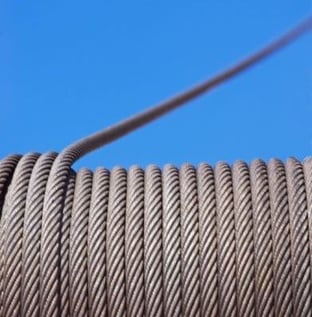Structural
Structural stretch is caused by the adjustment of wires and strands within a wire rope, along with compression of the core and lengthening of the lay. As the cable moves and works, its components shift slightly and settle. Many varying qualities contribute to the structural stretch of a wire rope, including its core size, construction, and lay lengths. If the rope is passed over a sheave, the amount of bending it is subjected to will also factor into its structural stretch. With all of these variables considered, you can roughly estimate the structural stretch of a wire rope by calculating 0.5% of its initial length.

Elastic
Elastic stretch is caused by the elongation of individual wires within a wire rope. Like a metallic rubber band, wire ropes that experience elastic stretch typically return to their initial length once the weight of a load is released or relieved. They are not, however, infinitely elastic. Though it is different from one wire rope to another depending on construction, material, etc., each wire rope has an elastic limit which will result in deformation if exceeded. As an example, the elastic limit of a stainless steel wire rope is approximately 60% of its breaking strength.
Age and Wear
Wire rope stretches quickly when it is first undertakes a load. It adjusts to its operating conditions during this initial phase, but will then stay relatively consistent for the rest of its cycle life. The rate of stretching will begin to change again once the rope wears and fatigues. You may even notice the diameter of the wire rope slimming down as it approaches the end of its service life.
Have questions about this or any other wire rope topic? Visit the contact page on our website to speak to our craftsmen today. To browse our selection of aircraft, architectural, or marine cable, or to learn more about our general purpose wire rope, visit https://strandcore.com/.

